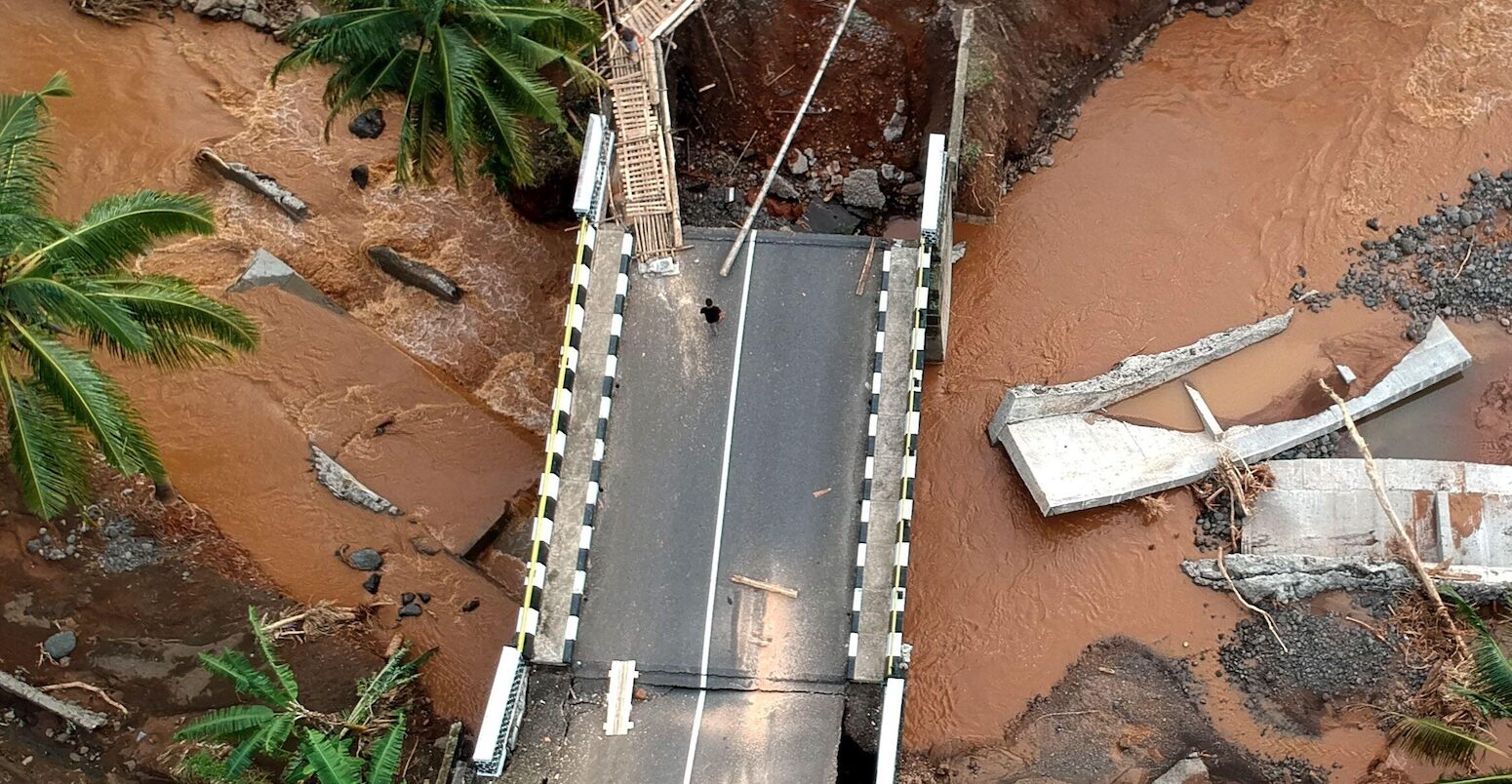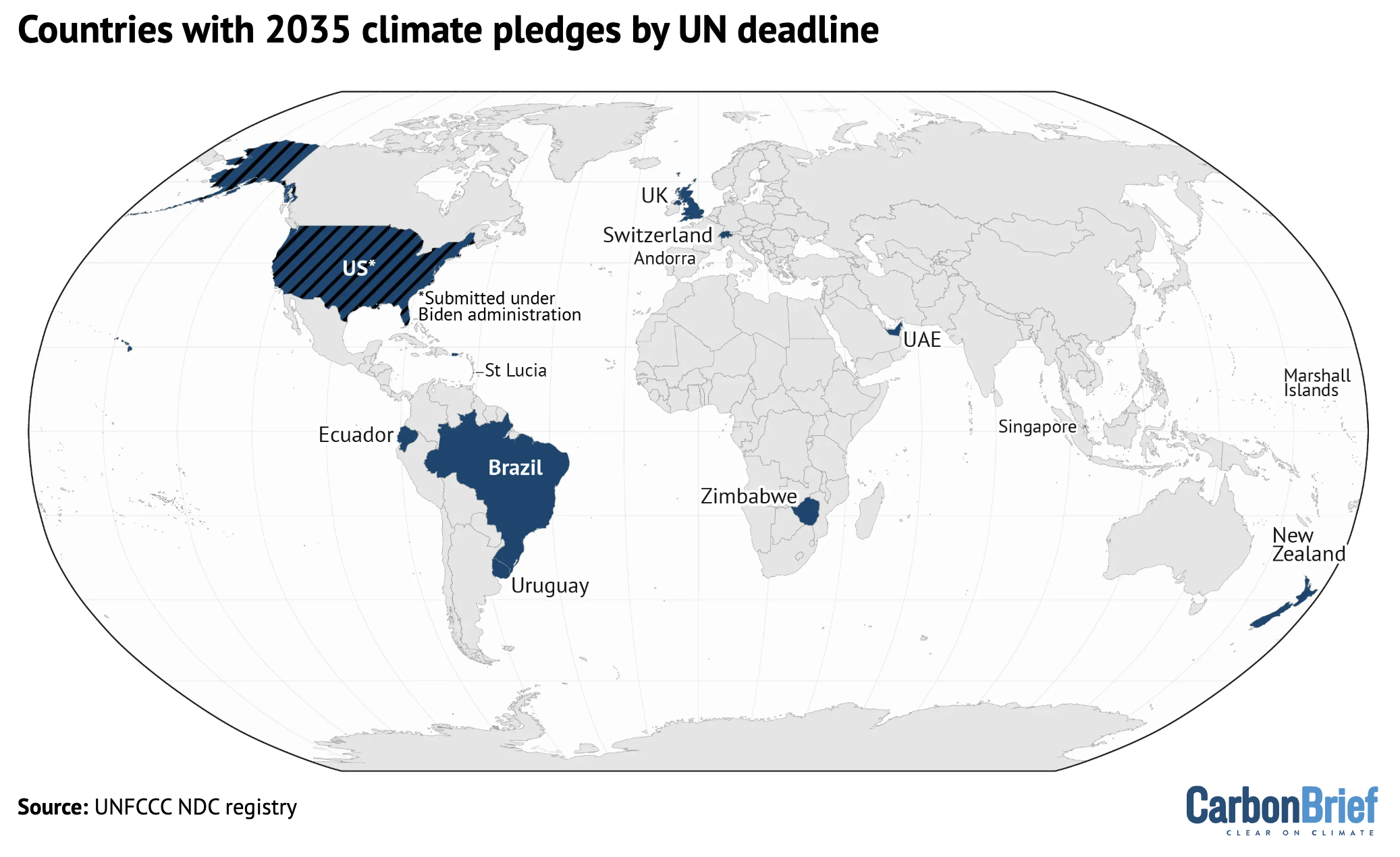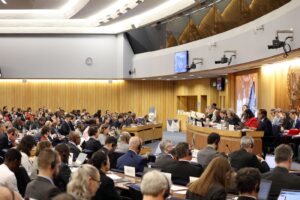
Analysis: 95% of countries miss UN deadline to submit 2035 climate pledges
Daisy Dunne
02.10.25Daisy Dunne
10.02.2025 | 8:00amNearly 95% of countries have missed a UN deadline to submit new climate pledges for 2035, Carbon Brief analysis shows.
Just 13 of the 195 parties signed up to the landmark Paris Agreement have published their new emissions-cutting plans, known as “nationally determined contributions” (NDCs), by the 10 February deadline.
Countries missing the deadline represent 83% of global emissions and nearly 80% of the world’s economy, according to Carbon Brief analysis.
The COP30 summit in Brazil this November is being billed as a key moment for countries to increase their efforts towards achieving the goals of the Paris Agreement.
In a 6 February speech, UN climate chief Simon Stiell said the “vast majority of countries have indicated that they [will] submit new plans this year” and “taking a bit more time to ensure these plans are first-rate makes sense”.
He added that countries need to submit their plans “at the latest…by September” in order to be included in the UN’s next global “synthesis” assessment of climate action ahead of COP30.
‘Quantum leap’
Back in 2015, almost every nation on Earth adopted the Paris Agreement, a landmark climate deal aimed at keeping temperatures “well-below” 2C above pre-industrial levels, with an ambition of keeping them at 1.5C, by the end of the century.
As part of the agreement, countries committed to submitting new plans describing what they will do to cut emissions and adapt to climate change every five years. These are known as NDCs.
Countries also agreed to assess their progress towards meeting the Paris goals in a five-yearly “global stocktake” and then increase their efforts accordingly.
This “review and ratchet” step is key to achieving the goals of the Paris Agreement. This is because, when the agreement was adopted 10 years ago, it was clear that countries were far off track for meeting their goals.
They hoped this gap could be closed over time, based on future policy efforts and technologies. As such, the so-called “ratchet mechanism” requires each round of pledges to go further than the last and to represent countries’ “highest possible ambition”.
The first two rounds of NDCs took place in 2015 and 2020-21. The 10 February 2025 deadline for the third round of NDCs was confirmed as part of a “global stocktake” of climate action conducted in 2023. The deadline is nine months ahead of the start of COP30.

According to the most recent UN emissions gap report, countries remain largely off track for meeting the Paris goals, with 2035 climate pledges needing to deliver a “quantum leap in ambition” to give the world a chance of limiting global warming to 1.5C.
However, just 13 of the 195 parties to the Paris Agreement have met the UN deadline to publish 2035 climate pledges by 10 February.
Only two of the group of seven (G7) nations – the US and the UK – have come forward with new climate plans. However, the US submitted its NDC before the inauguration last month of Donald Trump, who has already begun the process of delivering his campaign promise to withdraw the nation from the Paris Agreement.
These countries, along with the other nations to meet the deadline – Brazil, the United Arab Emirates, New Zealand, Switzerland, Uruguay, Andorra, Ecuador and Saint Lucia, the Marshall Islands, Singapore and Zimbabwe – are visualised on the map below.

Analysis by climate research group Climate Action Tracker has found that the new 2035 NDCs of Brazil, the UAE, the US and Switzerland are “not compatible” with a pathway for limiting global warming to 1.5C.
It also found that the UK’s new NDC is “1.5C compatible”, but noted that the nation would need to increase its spending on helping other countries tackle their emissions in order to do its “fair share” towards reaching the Paris goals.
The group has not yet analysed New Zealand’s NDC, but a climate expert within the country described it as “shockingly unambitious”.
Major polluters missing
Many of the world’s largest emitters have cited technical issues, economic pressures and political uncertainty as reasons why they have not been able to meet the UN deadline.
EU officials said the bloc’s lengthy process for approving new legislation made it “basically impossible” to meet the deadline.
China has not confirmed when it will release its climate plan.
Unnamed Indian officials have said they are in “no hurry” to release the nation’s NDC and might submit it in the “second half of this year”, according to the Indian Express. They added that India’s NDC will “reflect the disappointment of the climate finance outcome at COP29 in Baku”, a “hint” that it is “unlikely to be a significant or ambitious upgrade of climate actions”.
Canada, Japan and Indonesia have all released draft versions of their 2035 climate plans, but have yet to submit them to the UN. Canada’s plan has faced criticism for setting an emissions pledge that is less ambitious than what its official climate advisors recommended.
Russia has not made any public comments about when it will release its new NDC. Its last major climate update came in 2021, when it pledged to reach net-zero emissions by 2060.
Australia has indicated it will delay the release of its NDC until after the country’s election in May, “in part due to uncertainty about the ramifications of the US presidential election”, the Guardian reported.
At the COP29 climate summit in Azerbaijan in 2024, a group including Canada, Chile, the EU, Georgia, Mexico, Norway and Switzerland pledged to release “1.5C-aligned” NDCs, but did not offer details on how this would be achieved or commit to meeting the February deadline.
History repeats
Seasoned COP watchers will note that it is the norm for the majority of countries to miss the deadline for their NDCs.
During the last round of pledges, only five countries met the February 2020 deadline, with most countries eventually publishing their pledges later in 2020 and 2021. (This was amid the Covid-19 pandemic.)
During a speech in Brazil on 6 February, UN climate chief Simon Stiell said the “vast majority of countries have indicated they will submit new plans this year” and that he believed “countries are taking this extremely seriously”, adding:
“So taking a bit more time to ensure these plans are first-rate makes sense, properly outlining how they will contribute to this effort and therefore what rewards they will reap. At the latest, though, the [UN climate change] secretariat team needs to have them on their desks by September to include them in the NDC synthesis report, which will come out before the COP.”
This article was updated to include countries that submitted 2035 climate pledges to the UN by the evening of 10 February.
-
Analysis: 95% of countries miss UN deadline to submit 2035 climate pledges





